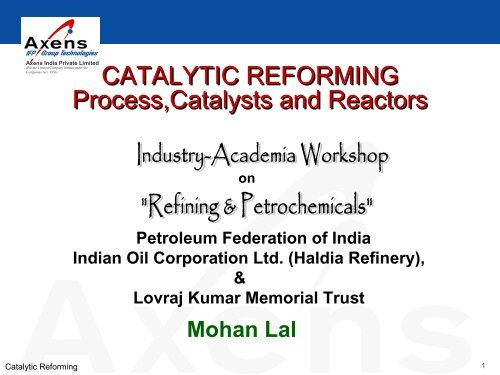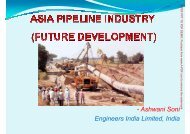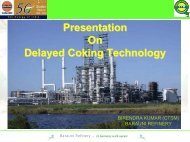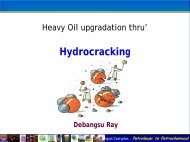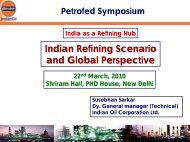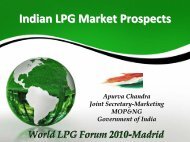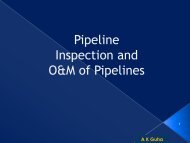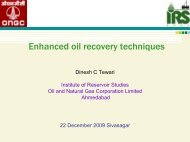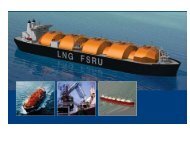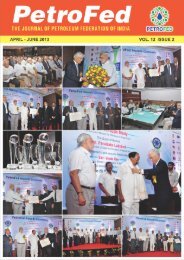CATALYTIC REFORMING Process,Catalysts and Reactors
CATALYTIC REFORMING Process,Catalysts and Reactors
CATALYTIC REFORMING Process,Catalysts and Reactors
Create successful ePaper yourself
Turn your PDF publications into a flip-book with our unique Google optimized e-Paper software.
Axens India Private Limited<br />
(Private Limited Company formed under the<br />
Companies Act, 1956)<br />
<strong>CATALYTIC</strong> <strong>REFORMING</strong><br />
<strong>Process</strong>,<strong>Catalysts</strong> <strong>and</strong> <strong>Reactors</strong><br />
on<br />
Petroleum Federation of India<br />
Indian Oil Corporation Ltd. (Haldia Refinery),<br />
&<br />
Lovraj Kumar Memorial Trust<br />
Mohan Lal<br />
Catalytic Reforming<br />
1
Introduction<br />
World context:<br />
High octane gasoline requirement<br />
Catalytic Reforming<br />
2
Introduction<br />
World context:<br />
Low sulfur content,<br />
Low benzene content,<br />
Limited aromatics content,<br />
Limited olefins content,<br />
No lead<br />
Catalytic Reforming<br />
3
Introduction<br />
European Gasoline specifications trends<br />
2000 2005 Soon*<br />
Ultimate<br />
Severity**<br />
Sulfur, ppm max 150 50 10 5<br />
Aromatics, vol% max 42 35 30 25<br />
Olefins, vol% max 18 18 14 10<br />
Benzene, vol% max 1 1 1 1<br />
Oxygen, wt% max - 2.7 2.7 2.7<br />
Vapor pressure, kPa<br />
max<br />
90 60 60 50<br />
C5+ ethers, vol%*** 15 15 15 15<br />
Lead, ppb max 5 5 5 5<br />
RON/MON, min 95/85 95/85 95/85 95/85<br />
* Assumed ** Projected final limits ≥ 2015 ***banned in several states of USA<br />
Catalytic Reforming<br />
4
Introduction<br />
Gasoline Pool specifications<br />
Bharat<br />
III<br />
Sulfur, ppm max 150<br />
Aromatics, vol% max 42<br />
Olefins, vol% max 21<br />
Benzene, vol% max 1<br />
Oxygen, wt% max -<br />
Vapor pressure, kPa max 60<br />
RON/MON, min 91/81<br />
Catalytic Reforming<br />
5
Introduction<br />
New gasoline specifications require:<br />
• Maintaining a high octane level<br />
• Meeting reduced sulfur specifications<br />
• Meeting reduced Aromatics <strong>and</strong> Benzene<br />
specifications<br />
Catalytic Reforming<br />
6
Introduction<br />
Constraints from straight run gasoline: Initial fractionation<br />
of crude oils gives gasoline cuts with a low octane number<br />
‣ Light gasoline (C5-C6) : RON between 60 <strong>and</strong> 70<br />
‣ Heavy gasoline (C7-C10) : RON between 30 <strong>and</strong> 50<br />
Refiners have to considerably improve the<br />
quality of gasoline cuts to meet RON/MON<br />
specifications<br />
Catalytic Reforming<br />
7
Introduction<br />
RON/MON is increased by chemical transformation<br />
• Light gasoline : Isomerization process<br />
n-paraffins i-paraffins<br />
Ex: n-Hexane (RON= 24.8) 2,2-DM Butane (RON=<br />
91.8)<br />
• Heavy gasoline: Catalytic Reforming process<br />
n-paraffins, naphtens aromatics<br />
Ex: Cyclohexane (RON = 83) Benzene (RON = 108)<br />
Catalytic Reforming<br />
8
Outline<br />
• Fundamentals of Catalytic Reforming<br />
• Objective<br />
• Reactions – desirable <strong>and</strong> undesirable<br />
• <strong>Process</strong><br />
• Semi Regenerative Reforming<br />
• Dualforming<br />
• Continuous Catalytic Regenerative Reforming<br />
• <strong>Process</strong> Variables<br />
• Reforming Catalyst<br />
• Types<br />
• Poisons<br />
• Some Recent Advances in Reforming<br />
• Update on CCR Technology / Catalyst<br />
• Update on SR Technology/ Catalyst / Debottle-necking<br />
Options<br />
Catalytic Reforming<br />
9
Fundamentals<br />
Catalytic Reforming<br />
10
Purpose of reformer<br />
Purpose of reformer<br />
• The purpose of Reforming process is to produce :<br />
- high octane number reformate, which is a main component for motor m<br />
fuel, aviation gasoline blending or aromatic rich feedstock.<br />
- hydrogen rich gas<br />
- Due to the nature of the reactions, reforming process produces also: a<br />
LPG – FG – 600 psig steam with the waste heat boilers<br />
Catalytic Reforming<br />
11
Purpose of reformer<br />
• Reformer feed is either:<br />
- Low quality straight run naphtha<br />
- or cracked naphtha, generally mixed with<br />
straight run naphtha.<br />
• Reformer feed pretreatment<br />
Due to the presence of contaminants in all cases <strong>and</strong> to<br />
the specific characteristics of cracked naphtha,<br />
Naphtha Pretreating unit(s) is(are) ) always necessary.<br />
Catalytic Reforming<br />
12
Chemical Reactions<br />
Catalytic Reforming<br />
13
Chemical reactions<br />
• Two types of reactions<br />
involved in the Octanizing<br />
process:<br />
– Desirable reactions, , which<br />
lead to a higher octane<br />
number <strong>and</strong> to high purity<br />
hydrogen production. They<br />
are the reactions to<br />
promote<br />
– Adverse reactions, , which<br />
lead to a decrease of<br />
octane number <strong>and</strong> a<br />
decrease in hydrogen<br />
purity. They are the<br />
reactions to minimize<br />
RON<br />
MON<br />
• Cyclohexane = 83 77.2<br />
• Methylcyclohexane = 74.8 71.1<br />
• 1.3 dimethylcyclohexane = 71.7 71.<br />
• Benzene = 114.8 > 100<br />
• Toluene = 120 103.5<br />
• m-Xylene<br />
= 117.5 115.<br />
RON:<br />
MON:<br />
Research Octane Number<br />
Motor Octane Number<br />
Catalytic Reforming<br />
14
Desirable reactions with hydrogen production<br />
• Naphthenes dehydrogenation<br />
– Naphthenic compounds dehydrogenated into aromatics with production<br />
on<br />
of 3 moles of H2 per mole of naphthene<br />
– Promoted by the metallic function<br />
– Highly endothermic<br />
– Thermodynamically favored by high temperature, low pressure <strong>and</strong> high<br />
number of carbons<br />
– Kinetically favored by high temperature, high number of carbon; not<br />
affected by the hydrogen partial pressure<br />
– At the selected operating conditions, reaction is very fast <strong>and</strong> almost<br />
total<br />
CH 2<br />
CH<br />
H C<br />
2<br />
CH 2<br />
HC<br />
CH<br />
+ 3H 2<br />
H C<br />
2<br />
CH 2<br />
HC<br />
CH<br />
CH 2<br />
Cyclohexane<br />
CH<br />
Benzene<br />
Catalytic Reforming<br />
15
Desirable reactions with hydrogen production<br />
• Paraffin's dehydrocyclization<br />
– Multiple step reaction<br />
– Promoted by both acidic<br />
<strong>and</strong> metallic functions<br />
CH 3<br />
CH 2<br />
CH 2<br />
CH 2<br />
CH 2<br />
CH 2<br />
CH 3<br />
CH<br />
CH CH 2 2<br />
CH CH 3 CH CH 2 3<br />
+ H<br />
2<br />
– Kinetically favored by high<br />
temperature, , <strong>and</strong> low<br />
pressure<br />
– Dehydrogenation step<br />
becomes easier as paraffin<br />
molecular weight increases,<br />
but is competed<br />
by hydro cracking<br />
– At the selected operating<br />
conditions, much lower<br />
rate than that of<br />
dehydrogenation<br />
CH 3<br />
CH<br />
C H<br />
7 16<br />
H C 2<br />
CH 2<br />
CH 2<br />
CH 2<br />
CH 2<br />
CH CH 2<br />
CH 3<br />
H C 2<br />
C H<br />
7 14<br />
CH 2<br />
CH 2<br />
CH 2<br />
CH 2<br />
CH<br />
Methylcyclohexane<br />
CH 2<br />
CH 2<br />
CH CH3 CH 3<br />
HC<br />
CH<br />
CH<br />
CH<br />
CH<br />
C<br />
CH 3<br />
+ 3H 2<br />
Catalytic Reforming<br />
16
Desirable reactions with hydrogen production<br />
• Linear paraffin's isomerization<br />
– Promoted by the acidic function<br />
– Slightly exothermic<br />
– Fast<br />
– Thermodynamically dependant on temperature; pressure has no<br />
effect<br />
– Kinetically favored by high temperature; not affected by the<br />
hydrogen partial pressure<br />
C H 7 16 C H 7 16<br />
Carbon atom<br />
C4<br />
C5<br />
C6<br />
C7<br />
C8<br />
% Isoparaffin at<br />
500°C<br />
44 58 72 80 88<br />
Catalytic Reforming<br />
17
Desirable reactions with hydrogen production<br />
• Naphthenes isomerization<br />
– Desirable reaction because of the subsequent dehydrogenation of the<br />
alkylcyclohexane into an aromatic<br />
– Difficulty of ring rearrangement <strong>and</strong> high risk of ring opening (paraffin(<br />
formation)<br />
– At the selected operating conditions, theoretically low rate but<br />
subsequent dehydrogenation shifts the reaction towards the desired<br />
ed<br />
direction<br />
– Slightly endothermic<br />
– Easier reaction for higher carbon number<br />
RON<br />
MON<br />
• Ethylcyclopentane = 67.2 61.2<br />
• Methylcyclohexane = 74.8 71.1<br />
• Toluene = 120 103.5<br />
Catalytic Reforming<br />
18
Adverse reactions<br />
• Hydrocraking<br />
– Hydrocracking affects either<br />
paraffins or olefins<br />
– Promoted by both acidic<br />
<strong>and</strong> metallic functions<br />
– Favored by high temperature<br />
<strong>and</strong> high pressure<br />
– Exothermic<br />
(risk of runaway reactions)<br />
– At the selected operating<br />
conditions, hydro cracking<br />
reaction could be complete,<br />
but is limited by kinetics<br />
C H<br />
7 16<br />
C H<br />
7 14<br />
C H<br />
4 8<br />
(m)<br />
+ H<br />
2<br />
+ H<br />
2<br />
(a)<br />
(m)<br />
C H<br />
7 14<br />
C H<br />
4 8<br />
C H<br />
4 10<br />
+<br />
+ H<br />
2<br />
C H<br />
3 8<br />
Catalytic Reforming<br />
19
Adverse reactions<br />
• Consequences of cracking:<br />
– Decrease of paraffins <strong>and</strong> increase of aromatics<br />
proportion (i.e. increase in octane) in the reformate <strong>and</strong> a<br />
loss of reformate yield<br />
– Decrease in hydrogen production (cracking reactions<br />
consume hydrogen)<br />
– Increase of light ends production <strong>and</strong> low molecular<br />
weight paraffins<br />
Catalytic Reforming<br />
20
Adverse reactions<br />
• Hydrogenolysis<br />
– Promoted by metallic function<br />
– Favored by high temperature <strong>and</strong> high pressure<br />
– Exothermic (risk of runaway reactions)<br />
or<br />
C H<br />
7 16<br />
+ H<br />
2<br />
CH 4<br />
+<br />
C H<br />
6 14<br />
C H<br />
7 16<br />
+ H<br />
2<br />
C H + 2 6<br />
C H<br />
5 12<br />
Catalytic Reforming<br />
21
Adverse reactions<br />
• Hydrodealkylation<br />
– Breakage of the branched radical of an aromatic ring<br />
– Promoted by metallic function<br />
– Favored by high temperature <strong>and</strong> high pressure<br />
– Consumes hydrogen <strong>and</strong> produces methane<br />
– But at the selected operating conditions, <strong>and</strong> with the selected catalyst,<br />
this reaction is not significant<br />
+ H<br />
2<br />
+ CH 4<br />
Xylene<br />
Toluene<br />
+ H<br />
2<br />
+ CH 4<br />
Toluene<br />
Benzene<br />
Catalytic Reforming<br />
22
Adverse reactions<br />
• Alkylation<br />
– Addition of an olefin molecule on an aromatic ring<br />
– Promoted by metallic function<br />
– leads to heavier molecules which may increase the<br />
end point of the product<br />
– High tendency to form coke; ; must be avoided<br />
CH 3<br />
+ CH 2<br />
= CH – CH 3<br />
HC<br />
Benzene Propylene Isopropylbenzene<br />
CH 3<br />
Catalytic Reforming<br />
23
Adverse reactions<br />
• Transalkylation (alkyl disproportionation)<br />
– Dismutation of 2 toluene rings to produce benzene <strong>and</strong> xylene<br />
– Promoted by metallic function<br />
– Favored by very severe conditions of temperature <strong>and</strong> pressure<br />
– At the selected operating conditions, <strong>and</strong> with the selected<br />
catalyst, this reaction is negligible<br />
+<br />
+<br />
Toluene<br />
Toluene<br />
Benzene<br />
Xylene<br />
Catalytic Reforming<br />
24
Adverse reactions<br />
• Coking<br />
– Results from a complex group of reactions. Detailed<br />
mechanism not fully known yet<br />
– Linked to heavy unsaturated products (polynuclear(<br />
aromatics)<br />
<strong>and</strong> heavy olefins traces or diolefins present in the feed or in<br />
CCR reactions<br />
– Coke deposit reduces active contact area <strong>and</strong> reduces<br />
catalyst activity<br />
– Favored by low pressure<br />
In Octanizing operating conditions, necessity of a<br />
continuous regeneration to maintain a low level of<br />
coke<br />
Catalytic Reforming<br />
25
Chemical reactions<br />
– All these reactions occur in series <strong>and</strong> parallel to each other producing p<br />
a<br />
complicated reaction scheme. In n an effort to simplify the scheme<br />
according to the reaction rates the main reactions take place in the<br />
following order:<br />
• 1st reactor<br />
• 2nd <strong>and</strong> 3rd reactors<br />
• 4th reactor<br />
Dehydrogenation<br />
Isomerization<br />
Dehydrogenation<br />
Isomerization<br />
Cracking<br />
Dehydrocyclization<br />
Cracking<br />
Dehydrocyclization<br />
Catalytic Reforming<br />
26
Catalyst Distribution<br />
• Highly endothermic transformation<br />
• Reaction rates vary widely<br />
The overall amount of catalyst<br />
needed for the transformation is distributed –<br />
not equally – among several adiabatic reactors<br />
in series with intermediary heaters providing<br />
the required heat energy input<br />
Catalytic Reforming<br />
27
Temperatures <strong>and</strong> Compositions<br />
inside <strong>Reactors</strong><br />
Reactor Temperature, °C<br />
H1 R 1 H2 R 2 H3 R 3<br />
T 0<br />
T 0 -25<br />
T 0 -50<br />
Composition, Vol%<br />
P 0 = 60<br />
N 0 = 30<br />
A 0 = 10<br />
Aromatics<br />
Naphthenes<br />
Paraffins<br />
Catalytic Reforming<br />
R 1 R 2 R 3<br />
Position in Reactor<br />
28
Chemical reactions<br />
– The catalyst distribution is:<br />
• R1 = 10%<br />
• R2 = 15%<br />
• R3 = 25%<br />
• R4 = 50%<br />
REACTIONS<br />
HEAT OF<br />
REACTION<br />
(1) KCAL/MOLE<br />
RELATIVE RATE<br />
(2) APPROX.<br />
Naphthenes dehydrogenation - 50 30<br />
Paraffin dehydrocyclization - 60 1 (base)<br />
Isomerization: Paraffins + 2<br />
Naphthenes + 4<br />
3<br />
Cracking + 10 0.5<br />
(1) Heat of reaction < 0 = endothermic reaction.<br />
(2) For pressure below 15 kg/cm2.<br />
Catalytic Reforming<br />
29
Reforming <strong>Process</strong>es<br />
Catalytic Reforming<br />
30
Fixed bed reformer<br />
• The most frequent type of unit<br />
• Current licensors<br />
• Axens, UOP<br />
• In the old days (Chevron, Amoco, Exxon,<br />
Engelhard)<br />
Interheater 1 Interheater 2<br />
1 2 3<br />
A<br />
B<br />
Separator<br />
Catalytic Reforming<br />
Feed<br />
Recycle<br />
Compressor<br />
Fuel Gas<br />
LPG<br />
Stabilized<br />
Reformate<br />
C<br />
31
Conventional Unit<br />
1 2 3<br />
Booster<br />
Compressor<br />
Separator<br />
Hydrogen-<br />
Rich Gas<br />
Recontacting<br />
Drum<br />
Feed<br />
Unstabilized<br />
Reformate<br />
Recycle<br />
Compressor<br />
Catalytic Reforming<br />
32
Dualforming<br />
Texicap+ RG682<br />
1 2 3<br />
C<br />
C<br />
R<br />
R<br />
X<br />
R<br />
e<br />
g<br />
e<br />
n<br />
C<br />
2<br />
Booster<br />
Compressor<br />
12b<br />
Hydrogen<br />
Rich<br />
Gas<br />
Recontacting<br />
Drum<br />
Feed<br />
Packinox<br />
Recycle<br />
Compressor<br />
Unstabilized<br />
Reformate<br />
• Last Reactor Catalyst Continuously Regenerated<br />
• Provides excellent option for the revamp of existing SR reformers<br />
Catalytic Reforming<br />
33
Continuous Catalytic Regenerative<br />
Reforming<br />
Catalytic Reforming<br />
34
Continuous Catalytic Regenerative<br />
Reforming<br />
Elutriator<br />
Reduction<br />
Chamber<br />
LC<br />
Upper Hoppers<br />
LC<br />
LC<br />
LC<br />
Upper<br />
Surge<br />
Drum<br />
Lock<br />
Hopper<br />
Coke<br />
<strong>Reactors</strong> R1 R2 R3 R4<br />
Regenerator<br />
Catalytic Reforming<br />
FC<br />
H 2<br />
FC<br />
H 2<br />
FC<br />
H 2<br />
FC<br />
• Catalyst Continuously Regenerated<br />
N 2<br />
N2<br />
FC<br />
Lower<br />
Hopper<br />
Lift<br />
Pot<br />
• With advanced catalysts longer catalyst life <strong>and</strong> less makeup<br />
rates possible<br />
35
Objectives of Regeneration Section<br />
Recover initial catalyst activity<br />
• Coke removal<br />
• Metal redistribution &<br />
chloride adjustment<br />
• Catalyst drying<br />
2 Burning zones<br />
Oxychlorination<br />
Calcination<br />
Each zone independently optimized<br />
Catalytic Reforming<br />
36
RegenC<br />
Combustion<br />
Gas<br />
from Dry Loop<br />
Additional<br />
Air<br />
Spent Catalyst<br />
Primary<br />
Burn<br />
Finishing<br />
Burn<br />
To Dry Burn<br />
Loop<br />
Burning with dry gas control:<br />
%O 2 , temperature<br />
Catalyst’s specific<br />
area is maintained<br />
Chloriding<br />
Agent<br />
+ water<br />
Oxychlorination<br />
Calcination Gas<br />
Oxychlorination<br />
Calcination<br />
Regenerated Catalyst<br />
To Effluent<br />
Treatment<br />
Oxychlorination control:<br />
% O 2 , temperature<br />
<strong>and</strong> moisture<br />
Optimum Pt dispersion<br />
Catalytic Reforming<br />
37
RegenC Catalyst Regenerator<br />
«Coked» Catalyst<br />
Combustion<br />
Gas Inlet<br />
Primary Burning<br />
Air Inlet<br />
Combustion<br />
Gas Outlet<br />
Oxychlorination Outlet<br />
Chloriding Agent<br />
Inlet<br />
Finishing Burning<br />
Oxychlorination<br />
Calcination<br />
Calcination Gas<br />
Inlet<br />
Regenerated Catalyst<br />
Catalytic Reforming<br />
38
<strong>Process</strong>es Variables<br />
Catalytic Reforming<br />
39
• Pressure<br />
• Temperature<br />
• Space velocity<br />
• Hydrogen partial pressure (H2/HC)<br />
• Quality of the feed<br />
• Operating Parameters Summary<br />
Catalytic Reforming<br />
40
<strong>Process</strong> variables<br />
• Each of them can be fixed by the operator - within<br />
the operating range of the equipment -<br />
independently from the others<br />
• For one set of independent variables, for same feed<br />
characteristics, there is only one performance of the<br />
unit i.e. one set of values for:<br />
– Product yields<br />
– Product quality (Octane)<br />
– Catalyst stability (coke make)<br />
Catalytic Reforming<br />
41
Pressure<br />
Catalytic Reforming<br />
42
Pressure<br />
• Pressure is the basic variable because of its<br />
inherent effect on reaction rates<br />
• Effect of pressure on reactions<br />
– Low pressures enhance hydrogen producing reactions:<br />
dehydrogenation, dehydrocyclisation, , coking<br />
– Cracking rate is reduced<br />
The lower the pressure, the higher the yields of<br />
reformate <strong>and</strong> hydrogen for a given octane number.<br />
But high coking rate (compensated by continuous<br />
regeneration)<br />
Catalytic Reforming<br />
43
Pressure<br />
• Average catalyst pressure used, close to last<br />
reactor inlet pressure<br />
• During transient conditions (start up,<br />
shutdown, upsets) it is recommended to<br />
increase the pressure to lower coke<br />
formation<br />
• Limits of operators action<br />
– Pressure rise limited by equipments design pressure<br />
– Pressure lowering limited by recycle compressor<br />
design power <strong>and</strong> intake volume<br />
Catalytic Reforming<br />
44
Temperature<br />
Catalytic Reforming<br />
45
Temperature<br />
• Most important <strong>and</strong> most used operating parameter with<br />
space velocity<br />
• Catalyst activity is directly related to reactor temperature. By<br />
simply raising or lowering reactor inlet temperatures, operators<br />
can raise or lower product quality <strong>and</strong> yields<br />
• It is commonly accepted to consider the weight average inlet<br />
temperature (WAIT)<br />
WAIT =<br />
( ) wt of catalyst R x Ti + ( ) x Ti2.... + ( )<br />
1<br />
1<br />
wt Catalyst R2<br />
Total wt of catalyst<br />
wt Catalyst R 4<br />
x Ti 4<br />
Where<br />
Ti1, Ti2, … are inlet temperature of reactors<br />
(wt of catalyst R1)… are weight of catalyst in reactors<br />
Catalytic Reforming<br />
46
Temperature<br />
• An increase of temperature (i.e. WAIT) has the following<br />
effects:<br />
– Increases octane<br />
– Decreases the yield (of C5+ fraction)<br />
– Decreases the H2 purity.<br />
– Increases the coke deposit<br />
• A slight increase of temperature (WAIT) through the life of<br />
the catalyst makes up for this activity loss<br />
• Larger <strong>and</strong> temporary changes in temperature are required:<br />
– To change octane - at constant feed quality <strong>and</strong> quantity<br />
– To change feed quantity <strong>and</strong> still maintain octane<br />
– To change feed quality <strong>and</strong> still maintain octane<br />
Catalytic Reforming<br />
47
Space Velocity<br />
Catalytic Reforming<br />
48
Space velocity<br />
• Weight hourly space velocity:<br />
WHSV =<br />
Weight of feed (per hour)<br />
Weight of catalyst in reactors<br />
• Liquid hourly space velocity:<br />
LHSV<br />
=<br />
Volume of feed at 15°<br />
C (per hour)<br />
Volume of catalyst in reactors<br />
• Linked to residence time of feed in the reactor <strong>and</strong><br />
affects the kinetics of the Reforming reactions<br />
Space<br />
velocity<br />
residence<br />
time<br />
higher<br />
severity<br />
Octane increased<br />
Lower reformate yield<br />
Higher coke deposit<br />
Catalytic Reforming<br />
49
Space velocity<br />
• Operators must bear in mind that each time<br />
liquid feed rate is changed, a temperature<br />
correction must be applied if octane is to be<br />
maintained.<br />
• Important recommendation<br />
– Always decrease reactor inlet temperature first <strong>and</strong><br />
decrease feed flowrate afterwards<br />
– Always increase feed flowrate first <strong>and</strong> increase<br />
reactor inlet temperature afterwards<br />
Catalytic Reforming<br />
50
Hydrogen to hydrocarbon ratio<br />
Catalytic Reforming<br />
51
Hydrogen to hydrocarbon ratio<br />
H Pure hydrogen (mole/hour ) in recycle<br />
• H2/HC ratio: 2<br />
=<br />
=<br />
HC<br />
Naphtha flow rate (mole/hour )<br />
H 2 HC<br />
= R M x Y<br />
F m<br />
Where R is the recycle flow in Kg/h (or lb/h)<br />
M is the recycle gas molecular weight<br />
F is the feed rate in Kg/h (or lb/h)<br />
m is the feed molecular weight<br />
Y vol. fraction of H2 in the recycle gas<br />
• The recycle gas MW is obtained by chromatographic<br />
analysis, as well as the H2 vol. fraction (Y)<br />
• The feed MW is obtained by chromatographic analysis<br />
or by correlation from its distillation range <strong>and</strong> specific<br />
gravity<br />
Catalytic Reforming<br />
52
Hydrogen to hydrocarbon ratio<br />
• Operators can change the H2/HC ratio by lowering<br />
or increasing the recycle compressor flow<br />
• For a given unit, the amount of recycle is limited by<br />
the recycle compressor characteristics (power,<br />
suction flow)<br />
• The H2/HC ratio has no obvious impact on the<br />
product quality or yield<br />
• But a high H2/HC ratio reduces the coke build up<br />
• It is strictly recommended to operate with a H2/HC<br />
ratio equal to (or higher than) the design figure<br />
Catalytic Reforming<br />
53
Feed quality<br />
Catalytic Reforming<br />
54
Feed quality Chemical composition<br />
• Characterization of the feedstocks by:<br />
• With a higher 0.85 N + A<br />
– The same Octane content will be obtained at a lower severity<br />
(temperature) <strong>and</strong> the product yield will be higher<br />
– Or for the same severity (temperature), the Octane content will be<br />
higher<br />
– Higher naphtenic content. The T<br />
endothermic reaction heat is<br />
increased <strong>and</strong> the feed flow rate will be limited by the heater design<br />
duty<br />
• With lower 0.85 N + A<br />
– Higher paraffin content. The hydrogen purity of the recycle gas<br />
decreases <strong>and</strong> operation will be limited by the recycle compressor<br />
capacity<br />
• Impurities<br />
0.85 N + A<br />
– Temporary or permanent reduction of catalyst activity by poisons<br />
contained in the feed<br />
Catalytic Reforming<br />
55
Feed quality Distillation range<br />
• The feed distillation range is generally as follows:<br />
• IBP (Initial Boiling Point) 70-100<br />
°C<br />
• EP (End Boiling Point) 150-180<br />
180 °C<br />
• Light fractions:<br />
Cyclization of C6 more difficult than that of C7-C8<br />
C8<br />
The lighter the feed, the higher the required<br />
severity for a given Octane<br />
• Heavy fractions:<br />
high naphthenic <strong>and</strong> aromatics content<br />
Lower severity to obtain good yields<br />
But polycyclic compounds which favor coke deposit<br />
EP higher than 180°C are generally not recommended<br />
Catalytic Reforming<br />
56
Operating Parameters Summary<br />
• Hereafter the theoretical effect on the unit performance of<br />
each independent process variable taken separately:<br />
Increased<br />
RONC<br />
Reformate yield<br />
Coke deposit<br />
Pressure<br />
Temperature<br />
Space velocity<br />
H2/HC ratio<br />
A + 0.85 N<br />
Naphtha<br />
Quality<br />
End boiling point<br />
Initial boiling point<br />
Catalytic Reforming<br />
57
<strong>Catalysts</strong><br />
Catalytic Reforming<br />
58
Catalyst<br />
The main characteristics of a catalyst other than its physical <strong>and</strong><br />
mechanical properties are :<br />
• The activity<br />
o catalyst ability to increase the rate of desired reactions<br />
o Is measured in terms of temperature<br />
• The selectivity<br />
o Catalyst ability to favor desirable reactions<br />
o Practically measured by the C5+ Reformate <strong>and</strong> Hydrogen<br />
yields<br />
• The stability<br />
o Change of catalyst performance ( activity, selectivity )with<br />
time<br />
o Caused chiefly by coke deposit <strong>and</strong> by traces of metals in feed<br />
o Measured by the amount of feed treated per unit weight of<br />
catalyst. C5+ wt reformate yield is also an indirect measure of<br />
the stability.<br />
Catalytic Reforming<br />
59
Catalyst<br />
• Catalyst<br />
• Chlorinated gamma alumina with nanao<br />
particle of Pt<br />
• The chlorinated gamma alumina has too<br />
strong acid sites<br />
• The Pt promotes hydrogenolysis of<br />
+ H2<br />
Pt<br />
Catalytic Reforming<br />
60
Catalyst<br />
• In the 90’s Procatalyse (now Axens)<br />
launched promoted Pt/Re catalyst<br />
• RG 582<br />
• Then RG 682 in 2000<br />
• The promoter provides two benefits<br />
• Reduced hydrogenolysis by a modification<br />
of the metallic cluster<br />
• Lower the number of the strongest acid<br />
sites<br />
Catalytic Reforming<br />
61
Catalyst<br />
• The stability of Pt has been improved by<br />
addition of promoters (Re, Ir)<br />
• The hydrogenolysis of Pt has been<br />
reduced by addition of promoters<br />
• The acidity of the chlorinated gamma<br />
alumina has been tuned by addition of<br />
promoters<br />
Catalytic Reforming<br />
62
Catalyst<br />
• To improve the catalyst stability the Pt sintering has to be<br />
hindered<br />
• Addition of promoters<br />
• Rhenium or Iridium<br />
• Explanation<br />
• Re <strong>and</strong> Ir is alloyed with Pt the “boiling point” of Pt is increased<br />
Sintering reduced<br />
1.00<br />
0.75<br />
Pt accessible<br />
Pt Total<br />
0.50<br />
• Operating conditions<br />
• T = 650°C<br />
• H2 = 2 000 L/kg/h 0.25<br />
Catalytic Reforming<br />
Pt + Re<br />
Pt<br />
0 10 20 30 40 50<br />
Time, hours<br />
63
• Reforming catalysts are bimetallic catalyst consisting of<br />
platinum plus promoters on an alumina support, Rhenium <strong>and</strong><br />
Tin being essentially one of the promoter besides the others.<br />
• The main features of these catalysts are :<br />
o High purity alumina support - High mechanical resistance<br />
o Platinum associated with Rhenium - high stability &<br />
selectivity<br />
o Platinum associated with Tin – high selectivity<br />
o High Regenerability<br />
Catalyst<br />
• The combination of these qualities give the following<br />
advantages:<br />
o High Reformate yield<br />
o High hydrogen yield<br />
o High on - stream factor<br />
o Low catalyst inventory<br />
Catalytic Reforming<br />
64
Catalyst<br />
‣Platinum (Pt) plus other promoter(s) impregnated on to<br />
gamma alumina containing around 1% wt chloride to<br />
provide acidity.<br />
‣Since 1967, bimetallic catalysts have been widely used.<br />
‣The second metal comes from the group<br />
Rhenium (Re)<br />
Tin (Sn)<br />
Iridium (Ir)<br />
Germanium (Ge)<br />
Catalytic Reforming<br />
65
WHICH METAL COMBINATION TO CHOOSE<br />
‣Depends on what you want from the catalyst - "THE<br />
OBJECTIVES"<br />
‣Stability / cycle life<br />
‣Selectivity towards<br />
hydrogen (H 2<br />
)<br />
liquid reformate (C 5<br />
+ reformate)<br />
benzene yield in C 5<br />
+ reformate<br />
Catalytic Reforming<br />
66
Stability<br />
• Normal causes for catalyst ageing/deactivation<br />
– metal sintering<br />
– temperature<br />
– metallic phase<br />
– presence of chloride<br />
– deposition of coke on metal <strong>and</strong> acid sites<br />
Coking effect can be split<br />
– 1. Degree of poisoning of deposited coke<br />
– 2. Relative coking rate<br />
Catalytic Reforming<br />
67
SELECTIVITY<br />
• Desired yields are:<br />
– hydrogen<br />
– C 5 + reformate<br />
– low benzene<br />
• Benzene<br />
– yield can be minimised by pre-fractionating the<br />
precursors (MCP, CH, nC6P) which are present in the<br />
fraction boiling between 70 to 85°C<br />
– benzene is also produced by the hydrodealkylation of<br />
alkyl benzenes<br />
• Loss of desired yields is caused by cracking<br />
– hydrocracking involving the metal plus acid sites<br />
– hydrogenolysis involving the metal in the presence of<br />
hydrogen<br />
Catalytic Reforming<br />
68
SUMMARY - EFFECT OF SECOND METAL<br />
• Tin <strong>and</strong> Germanium<br />
– increases selectivity towards desired products<br />
– no stability benefit<br />
• Rhenium <strong>and</strong> Iridium<br />
– increase stability<br />
– no major effect on yield selectivity<br />
• Other effects such as regenerability <strong>and</strong> tolerance to feedstock<br />
impurities has led to the PtRe combination being preferred catalyst<br />
Catalytic Reforming<br />
69
TRI METALLIC CATALYST<br />
• RG 582 introduced 1994<br />
• Third metal moderates hydrogenolysis activity to<br />
between that of balanced PtRe <strong>and</strong> PtSn<br />
• Desired yields increased<br />
– Hydrogen by 0.1 to 0.15wt%<br />
– C 5 + by around 1 wt%<br />
• Stability studies in pilot plant show 93 - 100% of<br />
balanced bimetallic catalyst, but in commercial units<br />
>100% is commonly seen.<br />
Catalytic Reforming<br />
70
Pilot test results<br />
Low pressure pilot test<br />
Selectivity<br />
C5+ yield<br />
Axens New series<br />
- Multi Promoted Catalyst<br />
- Reduced Pt content<br />
Previous Generation<br />
- Bi-promoted catalyst<br />
- High Pt content<br />
- Tri-promoted catalyst<br />
- Reduced Pt content<br />
Stability (time)<br />
Selectivity & stability improvement<br />
Catalytic Reforming<br />
71
Catalysis Mechanism<br />
• The catalyst affects reaction rates through its two different<br />
functions/type of sites:<br />
o Metallic, <strong>and</strong><br />
o Acidic<br />
Different types of reactions are promoted by these sites as:<br />
o Dehydrogenation Metallic<br />
o Dehydrocyclisation Metallic + Acidic<br />
o Isomerisation Metallic + Acidic<br />
o Hydrogenolysis Metallic<br />
o Hydrocracking Metallic + Acidic<br />
Catalytic Reforming<br />
72
<strong>Catalysts</strong> Poisons<br />
Catalytic Reforming<br />
73
Catalyst Contaminants<br />
Temporary poisons<br />
• Which can be removed <strong>and</strong> the proper Activity <strong>and</strong> Selectivity<br />
of catalyst is restored.<br />
• The most common temporary poisons ( inhibitors ) are:<br />
o<br />
o<br />
o<br />
o<br />
o<br />
Sulphur<br />
Organic nitrogen<br />
Water<br />
Oxygenated organics<br />
Halogens<br />
Catalytic Reforming<br />
74
Catalyst Contaminants (Contd…)<br />
Permanent poisons –<br />
Which induce a loss of activity which can not be restored.<br />
Main permanent poisons are<br />
• Arsenic<br />
• Lead<br />
• Copper<br />
• Iron<br />
• Nickel<br />
• Chromium<br />
• Mercury<br />
• Sodium<br />
• Potassium<br />
Catalytic Reforming<br />
75
Reactor Types<br />
Catalytic Reforming<br />
76
Typical Axial Fixed-Bed<br />
<strong>Reactors</strong><br />
Catalytic Reforming<br />
77
Typical Radial Fixed-Bed<br />
Reactor<br />
Bolted metal shroud <strong>and</strong> cover<br />
Catalyst<br />
Dead Space<br />
The design of the upper part of<br />
the reactor was made to take<br />
into account<br />
- density change (settling)<br />
- possible by-passing of catalyst<br />
- space for mechanical assembly<br />
Catalytic Reforming<br />
78
Typical Radial CCR Reactor<br />
Feed<br />
Catalyst<br />
Effluent<br />
Catalytic Reforming<br />
79
Texicap TM<br />
A New Concept of Radial Reactor<br />
Internals<br />
A Flexible Flow-guide that<br />
molds to the shape of the top of the bed<br />
Catalytic Reforming<br />
80
Typical Radial Fixed-Bed<br />
<strong>Reactors</strong><br />
BEFORE<br />
Bolted metal shroud <strong>and</strong> cover<br />
Catalyst<br />
Dead Space<br />
The design of the upper part of<br />
the reactor was made to take<br />
into account<br />
- density change (settling)<br />
- possible by-passing of catalyst<br />
- space for mechanical assembly<br />
Catalytic Reforming<br />
81
Modifying Radial Fixed-Bed<br />
<strong>Reactors</strong> with Texicap<br />
Catalyst<br />
Dead Space<br />
BEFORE<br />
AFTER<br />
Gained<br />
with<br />
Texicap<br />
Catalytic Reforming<br />
82
Catalyst Sampler<br />
Refilling<br />
Sampling Box<br />
Draining<br />
N 2<br />
ATM FL<br />
H<strong>and</strong>ling Head<br />
Receiving Pot<br />
Catalytic Reforming<br />
Drain<br />
83
Catalytic Reforming<br />
84


